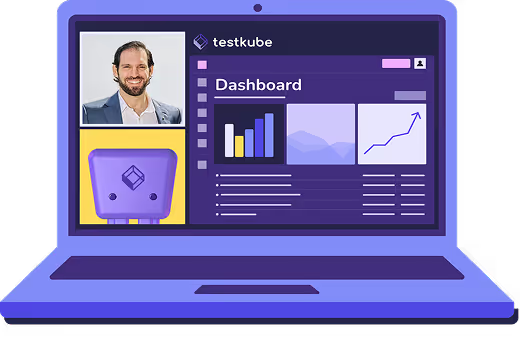Table of Contents
What Does API Testing Mean?
APIs (Application Programming Interfaces) are the backbone of modern applications, connecting services and enabling seamless integrations across microservices, mobile apps, web applications, and third-party systems. API testing is a critical software testing practice that ensures endpoints function correctly, perform efficiently, and remain secure throughout the development lifecycle.
API testing validates that endpoints:
- Return correct responses and handle edge cases appropriately
- Maintain optimal performance under varying load conditions
- Properly validate authentication, authorization, and data formats
- Comply with API specifications and industry standards
- Integrate smoothly with other services and components
Types of API Testing
Comprehensive API testing typically involves several layers of validation to ensure robust, production-ready APIs:
- Functional testing – Verifying that API responses are correct, complete, and meet business logic requirements
- Performance testing – Measuring response times, throughput, latency, and system behavior under concurrent requests
- Contract testing – Ensuring API specifications, schemas, and contracts are met between service providers and consumers
- Security testing – Validating authentication mechanisms, authorization controls, data encryption, and protection against common vulnerabilities like SQL injection and XSS attacks
- Integration testing – Confirming proper data flow, communication protocols, and interoperability between interconnected systems
- Regression testing – Ensuring that new code changes don't break existing API functionality
- Load testing – Assessing API behavior under heavy traffic and stress conditions
Common API Testing Approaches
Different API architectures require tailored testing strategies:
- REST API testing – Testing RESTful services using HTTP methods (GET, POST, PUT, DELETE) and validating JSON/XML responses
- GraphQL testing – Verifying query flexibility, mutation operations, and schema validation
- SOAP testing – Testing XML-based web services with WSDL specifications
- Webhook validation – Ensuring event-driven callbacks function correctly with proper payload delivery
- Microservices API testing – Validating service mesh communication and distributed system reliability
Why API Testing Matters
Modern software architectures rely on seamless service-to-service communication and API-driven integrations. Without proper API testing:
- Data flow between applications can break silently, causing cascading failures across dependent services
- Security vulnerabilities may go unnoticed, exposing sensitive data and creating attack vectors
- CI/CD pipelines can deliver unstable builds, undermining deployment confidence and release velocity
- Performance issues may only surface in production, impacting user experience and system availability
- Integration problems can cause downstream failures, affecting multiple teams and business processes
- Compliance requirements may be violated, leading to regulatory issues and legal exposure
For teams using Kubernetes, containerized environments, and CI/CD workflows, automated API testing is absolutely critical. It delivers fast feedback loops without depending on user interfaces, enables shift-left testing practices, and helps prevent flaky deployments that can derail release schedules.
Benefits of Automated API Testing
Implementing automated API testing provides numerous advantages:
- Faster time to market – Catch defects early in the development cycle
- Improved reliability – Ensure consistent behavior across environments
- Cost efficiency – Reduce manual testing effort and production incidents
- Better collaboration – Enable developers and QA teams to work from the same test specifications
- Continuous validation – Run tests automatically with every code commit
- Enhanced security posture – Regularly validate authentication and authorization mechanisms
Real-World API Testing Examples
Banking and Financial Services
A banking service runs automated Postman collections to verify critical API endpoints including login authentication, transaction processing, account balance retrieval, and fund transfer operations across staging clusters. These tests validate data accuracy, security compliance, and response time requirements before production deployment.
E-Commerce Platforms
An e-commerce platform implements comprehensive API testing for product search APIs, payment processing endpoints, inventory management flows, order fulfillment services, and customer account management. Testing these critical paths ensures reliability, catches errors before they impact customers, prevents revenue loss, and maintains seamless shopping experiences during peak traffic periods.
Healthcare Applications
Healthcare providers test patient record APIs, appointment scheduling endpoints, prescription management services, and insurance verification integrations to ensure HIPAA compliance, data accuracy, and system availability for critical medical workflows.
SaaS Applications
Software-as-a-Service companies validate subscription management APIs, user authentication flows, billing integrations, feature flag endpoints, and webhook deliveries to maintain service quality and support multi-tenant architectures.
Best Practices for API Testing
To maximize the effectiveness of your API testing strategy:
- Test early and often – Integrate API tests into your development workflow
- Use realistic test data – Include edge cases, boundary conditions, and production-like scenarios
- Automate regression suites – Run tests continuously in CI/CD pipelines
- Monitor API performance – Track response times and set performance baselines
- Version your test suites – Maintain tests alongside API documentation
- Test error handling – Verify graceful degradation and meaningful error messages
- Validate across environments – Ensure consistency from development to production
API testing is an essential component of modern software quality assurance, enabling teams to build resilient, secure, and high-performing applications in today's interconnected digital landscape.
How API Testing Works with Testkube
Testkube integrates directly with popular API testing tools:
- Postman collections and REST Assured can be executed inside Kubernetes clusters.
- Tests run as part of your CI/CD pipeline, providing instant feedback.
- Centralized reporting and stored artifacts give visibility into test results across environments.





